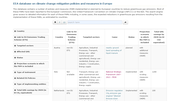
This database contains a number of policies and measures (PAM) implemented or planned by European countries to reduce greenhouse gas emissions. Most of these PAMs have been reported to the European Commission, the United Framework Convention on Climate Change (UNFCCC) or the EEA. The search engine gives access to detailed information for each of these PAMs including, in some cases, the expected reductions in greenhouse gas emissions resulting from the implementation of these PAMs, as estimated by countries.

Line graph of changes over time in consumption per capita for poultry, cheese, fish and seafood, milk, meat, pork and beef (index: 1995 = 100)

The map captures some of the complexity of the multiple demands
on land resources, with urban sprawl, agricultural intensification
and land abandonment exerting pressures on biodiversity and water
resources.

CH4 emissions excluding sector 5, LULUCF (land use, land use change and forestry)

Dark green dots correspond to concentrations under the WHO reference level (0.12 ng/m3).
Pale green dots correspond to concentrations under the lower assessment threshold (0.4 ng/m3).
Orange dots correspond to concentrations between the lower and the upper assessment threshold (0.6 ng/m3).
Red dots correspond to concentrations above the upper assessment threshold but under the target value of 1 ng/m3.
Dark red dots correspond to concentrations exceeding the target value of 1 ng/m3.

The map shows the annual mean benzene concentrations in 2011, based on annual averages with percentage of valid measurements >= 50% in μg/m3

The four maps shows the annual mean concentrations of arsenic, cadmium, lead and nickel in the year 2011

The data presented were derived from a consistent set of stations in all years.
Statistically significant trends (level of significance 0.1) are calculated by applying the Mann-Kendall test. Increasing concentrations are indicated with red dots and decreasing concentrations with green dots, when statistically significant. The applied method is described in de Leeuw, 2012.

The figure shows percentage of the EU urban population exposed to air pollution exceeding WHO air quality guidelines

The graph is based on the annual mean concentration values for each Member State; the boxes present the range of
concentrations at all stations types (in μg/m3) officially reported by the EU Member States and how the concentrations relate
to the limit value set by EU legislation (marked by the red line).
The diagram indicates the lowest and highest observations, the means and the lower and upper quartiles. The lower quartile
splits the lowest 25 % of the data and the upper quartile splits the highest 25 % of the data.

The graph shows the development in As (and
other heavy metals) emissions reported by the
EU Member States between 2002 and 2011 as a
percentage of 2002 emissions.

The graph is based on the maximum daily 8-hour mean value of CO concentrations (in mg/m3) for each Member State; the
boxes present the range of concentrations at all stations types officially reported by the EU Member States and how the
concentrations relate to the limit value set by EU legislation (marked by the red line).
The diagram indicates the lowest and highest observations, the means and the lower and upper quartiles. The lower quartile
splits the lowest 25 % of the data and the upper quartile splits the highest 25 % of the data.

Monitoring data from AirBase provide the basis for
estimating the European population's exposure to
exceedances of the SO2 limit value of 125 µg/m3
as a daily average. According to the relevant
directive, this limit value should not to be exceeded
on more than three days in a year and was to be
met by 2005.

The red line corresponds to the EU limit value of 125 μg/m3, EU Member States only.
The graph is based on the 99.18 percentiles of the daily mean concentration values for each Member State; the boxes
present the range of the 99.18 percentiles at all stations types (in μg/m3) with data officially reported by the EU Member
States and how they relate to the daily limit value set by EU legislation (marked by the red line).
The diagram indicates the lowest and highest observations, the means and the lower and upper quartiles. The lower quartile
splits the lowest 25 % of the data and the upper quartile splits the highest 25 % of the data.

The NO2 monitoring data in AirBase provide the
basis for estimating the exposure of the European
population to exceedances of the NO2 annual mean
limit value of 40 µg/m3. Figure 4.4 presents this data
for the period 2002–2011, based on NO2 measured
at urban background monitoring stations.

The graphs are based on annual mean concentration trends (top) and the trends in percentile 99.78 of NO2 hourly values
(bottom); they present the range of concentration changes per year (in μg/m3) per station type (urban, traffic, rural, and
other — mostly industrial). The trends are calculated based on the officially reported data by the EU Member States with a
minimum data coverage of 75 % of valid data per year for at least 8 years out of the 10-year period.
The diagram indicates the lowest and highest trends, the means and the lower and upper quartiles, per station type. The
lower quartile splits the lowest 25 % of the data and the upper quartile splits the highest 25 % of the data.

The O3 monitoring data in AirBase provide the basis
for estimating the urban exposure of the European
population to exceedances of the EU's O3 target
value (applicable from 2010) for the protection of
human health, for the period 2002–2011.

CH4 emissions are total emissions (IPPC sectors 1–7) excluding sector 5, LULUCF (land use, land use change and forestry).

This figure shows the sectoral output of primary PM and precursor gases
Various source sectors contribute to the primary
anthropogenic PM and precursor gases
Document Actions
Share with others